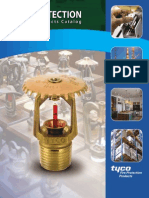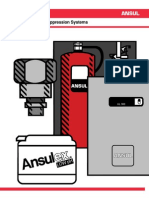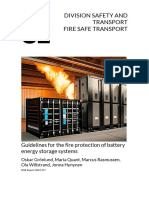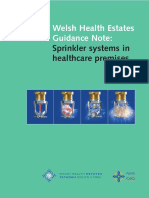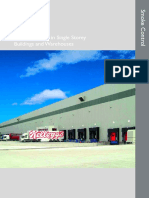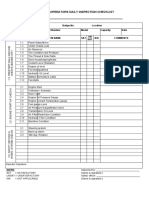0 ratings0% found this document useful (0 votes)
111 viewsKAPB Smoke Control in Car Parks
KAPB Smoke Control in Car Parks
Uploaded by
miniongsky1) The document discusses smoke control standards for car parks being developed by CEN TC191 SC1 WG9. Both ducted and jet fan systems will be covered by the new European standard.
2) Extensive research has been conducted to determine appropriate heat release rates for vehicle fires. A three-option approach using steady-state, time-dependent, and CTICM curves was agreed upon.
3) A case study was presented on a large multifunctional development project in Hasselt, Belgium that included a very large car park. Smoke control design followed various European standards and criteria.
Copyright:
© All Rights Reserved
Available Formats
Download as PDF, TXT or read online from Scribd
KAPB Smoke Control in Car Parks
KAPB Smoke Control in Car Parks
Uploaded by
miniongsky0 ratings0% found this document useful (0 votes)
111 views53 pages1) The document discusses smoke control standards for car parks being developed by CEN TC191 SC1 WG9. Both ducted and jet fan systems will be covered by the new European standard.
2) Extensive research has been conducted to determine appropriate heat release rates for vehicle fires. A three-option approach using steady-state, time-dependent, and CTICM curves was agreed upon.
3) A case study was presented on a large multifunctional development project in Hasselt, Belgium that included a very large car park. Smoke control design followed various European standards and criteria.
Original Description:
ventilation
Copyright
© © All Rights Reserved
Available Formats
PDF, TXT or read online from Scribd
Share this document
Did you find this document useful?
Is this content inappropriate?
1) The document discusses smoke control standards for car parks being developed by CEN TC191 SC1 WG9. Both ducted and jet fan systems will be covered by the new European standard.
2) Extensive research has been conducted to determine appropriate heat release rates for vehicle fires. A three-option approach using steady-state, time-dependent, and CTICM curves was agreed upon.
3) A case study was presented on a large multifunctional development project in Hasselt, Belgium that included a very large car park. Smoke control design followed various European standards and criteria.
Copyright:
© All Rights Reserved
Available Formats
Download as PDF, TXT or read online from Scribd
Download as pdf or txt
0 ratings0% found this document useful (0 votes)
111 views53 pagesKAPB Smoke Control in Car Parks
KAPB Smoke Control in Car Parks
Uploaded by
miniongsky1) The document discusses smoke control standards for car parks being developed by CEN TC191 SC1 WG9. Both ducted and jet fan systems will be covered by the new European standard.
2) Extensive research has been conducted to determine appropriate heat release rates for vehicle fires. A three-option approach using steady-state, time-dependent, and CTICM curves was agreed upon.
3) A case study was presented on a large multifunctional development project in Hasselt, Belgium that included a very large car park. Smoke control design followed various European standards and criteria.
Copyright:
© All Rights Reserved
Available Formats
Download as PDF, TXT or read online from Scribd
Download as pdf or txt
You are on page 1of 53
Imagine the result
Smoke control in car parks
The actual situation in CEN TC 191 SC1 WG9
Jean-Claude DE SMEDT MIFireE,MSFPE,MNFPA
Senior Fire Safety Engineering Consultant @ ARCADIS
Belgium
Convener of CEN TC191 SC1 WG9 Smoke Control in
Car Parks
About ARCADIS
What we do
Consultancy, design, engineering and
management services
In infrastructure, water, environment and
buildings
For companies and governments
Our mission
We want to be the leader in Flanders, Brussels
and Wallonia for complex projects in our fields
of activity
A solid
partner with
healthy
growth
Top 3 in Belgium for consultancy and engineering
Annual revenues in millions ! People (FTE)
Strong local
presence
Antwerp Berchem
Ghent
Hasselt
Leuven
Brussels
Charleroi
Luik
A worldwide
network
based on
strong local
positions
15.000 people strong and ! 2 billion in annual
revenues
A worldwide netwerk for consistent quality to
multinational clients in Europe, North and
South America
Top 3 in Europe and top 10 worldwide
Quoted on Euronext
Smoke control in
car parks
The actual situation in CEN
TC 191 SC1 WG9
Both systems
will be
covered by
the European
standard
ducted
systems as
well as jet fan
systems
Scope
This standard gives minimum design,
installation and commissioning
requirements for powered smoke and heat
control systems for enclosed car parks, with or
without sprinkler protection, on one or more
levels, for cars and light commercial vehicles
(max 3,5 T), to reach the design objectives
outlined in this standard.
This standard is applicable for cars powered by
petrol or diesel or other fuels which will have a
fire performance similar to vehicles powered by
petrol or diesel.
This standard only covers traditional means of
single vehicle parking, that is, those car parks
with cars parked alongside each other with
common access roadways/lanes for cars to be
driven in and out.
Scope
It does not cover other forms of car parking
systems, such as stacking systems.
Smoke and heat control systems for lorry
parks and coach parks are not covered by
this standard.
This standard covers systems intended
1. to provide smoke clearance after a fire
(system 1),
2. to assist active fire!fighting operations
(system 2),
3. to protect the means for occupants to escape
from the car park (system 3)
Controls of and power supplies to the smoke
control system are included.
This standard does not cover requirements
for normal day!to!day ventilation
CEN TC191
SC1 WG9
So far we had 10 meetings in EUROPE and
2 more meetings planned in 2011 (Antwerp &
Paris)
The activities started in December 2008
Participating countries:
Austria, Belgium, France, Finland, Germany,
Italy, Poland, Spain, The Netherlands,
Luxemburg and UK
At this moment we have about 125
documents into our portfolio
A TG1 has been created within CEN TC191
SC1 WG9
Will deal with the parts of the standard
dealing with CFD
Chaired by Grzegorz SZTARBALA from
Poland
A first draft based on the Belgian
Standard & British standards had
been prepared and discussed
After discussion and analysis of this
draft text we came to the conclusion
that these two standards where
mainly based on inspired
guessworkand that it was not
possible to adopt a calculation
method as such
Also some problems occur when we
started to discuss the Fire Sizes for
cars
To proceed with the discussions and make a final choice regarding
Fire sizes we have invited Daniel JOYEUX from EFECTIS France who
had been involved into a major research program in 1999 at CTICM
and Martin SHIPP from BRE - FRS who recently lead the recent
research in UK
CTICM HRR BRE TESTS
Further to these both presentations it
was agreed to use following values
for HRR:
Single burning car = 4 MW (Sprinklered
fire)
Two cars burning = 8 MW
Three cars burning = 10 MW
A 3 option approach has been
suggested:
Steady state
Standard 3 car time dependent curve
Special time dependent curved based on
1st and subsequent curves from CTICM
In order to proceed with the
calculation procedure it has been
agreed to adopt the method
published in 1999
Extending the principles of
Impulse Ventilation in Tunnels to
apply to Smoke Control in Car
Parks
By
H. P. Morgan B Sc, PhD, C Phys, M Inst
P, C Eng, F I Fire E
B. Vanhove, ir-arch
J-C. DeSmedt, MIFireE,MNFPA,MSFPE
This calculation method allows to
calculate the horizontal spread of the
ceiling jet under the ceiling and takes
into account the type of ceiling
present in the car park.
The velocity of the ceiling jet will vary
if there is a flat ceiling,a ceiling with
transversal beams or longitudinal
beams
Situation with longitudinal beams Situation with a flat ceiling
Situation with transversal beams
We are very hopeful that in addition
to the results of the CTICM research
and FRS/ BRE research we also will
be able to utilize the results of a
large research program which takes
place in Gent at Ugent which will
certainly validate everything we have
so far!
Fire IVRY/
SEINE (level
-3)
This fire started in Paris on 31/10/2009
in an underground car park under a
residential building was announced in
the press as been a fire where 200
cars where destroyed
Each level had an area of 3600 m" and
was separated in two areas of about
1.800 m" separated by a fire door
All the levels had separated boxes
where the owners could park their cars
This building was situated in an area
where a lot of vandalism takes place
and therefore most of the people did
not want to park their car in the
garages anymore
Fire IVRY/
SEINE (level
-3)
Most of the garage boxes have been
used as a storage room(see photos)
with a high fire risk potential
The investigation suspect that this fire
is a criminal fire as they found two
ignition sources
They have fires in this building very
regularly
This fire lasted 5 hours
The fire started at level -3 and
spreaded towards levels -2 & -1
through the dilatation joints and
probably also through conduction in
several garages baring in mind the high
potential risk
Fire IVRY/
SEINE (level
-3)
The Paris Fire Brigade have
extinguished the fire by injecting foam
through the ventilation ducts
37 cars have been destroyed by this
fire (and not 200 !!) as stated in the
press
No comments needed#
No comments needed#
No comments needed#
Fire Safety & Smoke
Control in a
Multifunctional project
including a very large car
park in Hasselt, Belgium
Design
criteria
Smoke control: following BR186 &
BR368 including NBN EN 12 101-5 for
the shopping Center
Car Parks: following the Belgian
standard NBN S21 208-2 & calculation
of the ceiling jet velocity
Large stores: following the Belgian
standard NBN S21 208-1 &
NBN EN 12 101-5
Sprinkler system: following CEA 4001
Smoke Detection: following EN54-14
Fire Safety Level Kade
1
700
S
m
o
k
e
F
r
e
e
H
e
i
g
h
t
3
0
0
0
4
5
0
0
5
9
0
0
No downstand
1400
SHEVS
duct
SHEVS
duct
Shops
Promenade
Evacuation level
Promenade
Motorised
dampers
Evacuation
shaft
Shops Kade
Parking -1
Parking -2
SHEVS
fans
3
.
0
0
m
SHEVS
Shaft
Shops
Kade
4
.
6
0
m
6
.
1
0
m
Sidewall sprinklers Sprinklers
SHEVS
duct
S
m
o
k
e
F
r
e
e
H
e
i
g
h
t
3
.
0
0
m
4
.
6
0
m
6
.
1
0
m
M
i
n
.
3
.
5
0
m
Sidewall sprinklers
Sprinklers
SHEVS
duct
S
m
o
k
e
F
r
e
e
H
e
i
g
h
t
3
.
0
0
m
4
.
6
0
m
6
.
1
0
m
M
i
n
.
3
.
5
0
m
Sidewall sprinklers
Sprinklers
SHEVS
duct
First approach
for SHEVS
SHEVS principle level -1
Sprinklers Jet fans
Sprinklers
Impulse fans
Private parking Public parking
inductie-
ventilatoren
inductie-
ventilatoren
stuwkracht-
ventilatoren
autobrand
schacht 1
schacht 2
schacht 3
schacht 4
dwarsbalken
In/uitrit
283 m
115 m
67 m
HRR-curve
Air velocity vectors without fire Air velocity vectors with fire
Visibility
Temperature at
1.7m & 2.6m
SHEVS for level -2
SHEVS for level -3
IMAGINE THE
RESULT
THANK YOU
You might also like
- BR 187Document69 pagesBR 187mukeshsinghtomarNo ratings yet
- The Powder Hole's Story-2002aDocument22 pagesThe Powder Hole's Story-2002aRoger Gilbert50% (2)
- Montacargas Toyota Serie 8Document12 pagesMontacargas Toyota Serie 8Miguelangel Contreras SanchezNo ratings yet
- Alan Beard, Richard Carvel (Eds) - Handbook of Tunnel Fire Safety-ICE Publishing (2012)Document681 pagesAlan Beard, Richard Carvel (Eds) - Handbook of Tunnel Fire Safety-ICE Publishing (2012)Ma Man KinNo ratings yet
- Smoke Control in Atrium Buildings Roger Harrison PDFDocument320 pagesSmoke Control in Atrium Buildings Roger Harrison PDFMustafa Oksuz100% (1)
- NZICC Fire Engineering Peer ReviewDocument11 pagesNZICC Fire Engineering Peer ReviewStuff NewsroomNo ratings yet
- SSLD 8 SprinklersDocument48 pagesSSLD 8 SprinklersIonio PelagosNo ratings yet
- Enclosure FiresDocument194 pagesEnclosure FiresHellen Martinsson100% (2)
- Sprinklers in Schools PDFDocument48 pagesSprinklers in Schools PDFGabetsos KaraflidisNo ratings yet
- High-Rise Fire Protection System Design - Zoning & Series PumpingDocument4 pagesHigh-Rise Fire Protection System Design - Zoning & Series PumpingminiongskyNo ratings yet
- Creating Resilient Supply Chains - A Practical GuideDocument100 pagesCreating Resilient Supply Chains - A Practical GuidePeter KlymNo ratings yet
- Airbus A320Neo Checklist: Power Up The AircraftDocument4 pagesAirbus A320Neo Checklist: Power Up The AircraftmcameraNo ratings yet
- Foam For Fixed SystemDocument2 pagesFoam For Fixed SystemRukman SetiawanNo ratings yet
- Tyco - Window Sprinklers As An Alternative To Fire PDFDocument19 pagesTyco - Window Sprinklers As An Alternative To Fire PDFingenierosunidosNo ratings yet
- Review On Fire Safety in Car Parking: April 2019Document5 pagesReview On Fire Safety in Car Parking: April 2019Md. Mominul IslamNo ratings yet
- MINIMAX - Fire Protection For Wind Turbines PDFDocument8 pagesMINIMAX - Fire Protection For Wind Turbines PDFgeorgecis100% (1)
- RFModernVehicleHazards in ParkingGaragesDocument60 pagesRFModernVehicleHazards in ParkingGaragesSameh EzzatNo ratings yet
- Egress and Fire ProtectionDocument30 pagesEgress and Fire ProtectiontuNo ratings yet
- Protecting Parking Garages - NFPADocument7 pagesProtecting Parking Garages - NFPAJohn KupchaNo ratings yet
- SCA Guidance-June 21Document70 pagesSCA Guidance-June 21БогданNo ratings yet
- 2 B ET MF Lithium-ion-Hazard-ProtectionDocument8 pages2 B ET MF Lithium-ion-Hazard-Protectionyerrisiddappa KNo ratings yet
- Appendix A - Flame Radiation ReviewDocument10 pagesAppendix A - Flame Radiation ReviewTorero02No ratings yet
- Mechanical Smoke Extract Shaft Systems: Presented byDocument8 pagesMechanical Smoke Extract Shaft Systems: Presented byErnest OdhiamboNo ratings yet
- CFPA E Guideline No 19 2023-FDocument43 pagesCFPA E Guideline No 19 2023-Fgerard.ingenieriaNo ratings yet
- UK - KIP - Real Fire Case StudiesDocument20 pagesUK - KIP - Real Fire Case StudiesTolga YazanNo ratings yet
- Fire Sprinkler Systems: A Guide To Designs, Colour Codes and SuppliersDocument68 pagesFire Sprinkler Systems: A Guide To Designs, Colour Codes and SuppliersRan CarilloNo ratings yet
- 1300 Burj Dubai Life Safety and Crisis Response Planning EnhancementsDocument9 pages1300 Burj Dubai Life Safety and Crisis Response Planning EnhancementsNugraha Eka SaputraNo ratings yet
- (SpringerBriefs in Applied Sciences and Technology) Gabriele Bernardini (Auth.) - Fire Safety of Historical Buildings - Traditional Versus Innovative "Behavioural Design" Solutions by Using WayfindingDocument117 pages(SpringerBriefs in Applied Sciences and Technology) Gabriele Bernardini (Auth.) - Fire Safety of Historical Buildings - Traditional Versus Innovative "Behavioural Design" Solutions by Using Wayfindingoverlord5555No ratings yet
- Smoke and Heat Control Systems: BSI Standards PublicationDocument42 pagesSmoke and Heat Control Systems: BSI Standards PublicationAfsaneh ghanbarianNo ratings yet
- Study Report: Car Parks - Fires Involving Modern Cars and Stacking SystemsDocument108 pagesStudy Report: Car Parks - Fires Involving Modern Cars and Stacking SystemsBerkan KayadanNo ratings yet
- Rak-43.3520 Fire Simulation: Simo HostikkaDocument23 pagesRak-43.3520 Fire Simulation: Simo HostikkamarmoladynaNo ratings yet
- Fire Protection 1700404110Document144 pagesFire Protection 1700404110raja ahmedNo ratings yet
- Tyco Fire Products GPC 03-14Document100 pagesTyco Fire Products GPC 03-14hlagos123100% (2)
- Fire Protection Module 2020 PDFDocument60 pagesFire Protection Module 2020 PDFVELASCO JULIE-ANN G.100% (1)
- Guidelines On Formulation of FS Requirements For New Railway Infrastructures - Sept 2013 2nd Edition PDFDocument192 pagesGuidelines On Formulation of FS Requirements For New Railway Infrastructures - Sept 2013 2nd Edition PDFMiniEscort100% (1)
- Guidelines International Fire Engineering 2005Document415 pagesGuidelines International Fire Engineering 2005William Ivans100% (1)
- KNPD Access For All Design Guidelines 2013Document78 pagesKNPD Access For All Design Guidelines 2013Gilbert BartoloNo ratings yet
- Lecture 02Document20 pagesLecture 02ChristianNo ratings yet
- Ansul R-102 Restaurant Fire Suppression Systems F-8879Document8 pagesAnsul R-102 Restaurant Fire Suppression Systems F-8879Grbayern MunchenNo ratings yet
- Fire Dynamics II: Lecture # 1 Introduction / Enclosure PhenomenaDocument23 pagesFire Dynamics II: Lecture # 1 Introduction / Enclosure PhenomenaBasil OguakaNo ratings yet
- Guidelines For The Fire Protection of Battery Energy STDocument68 pagesGuidelines For The Fire Protection of Battery Energy STxcb32No ratings yet
- Chapter 4Document142 pagesChapter 4Derbel WalidNo ratings yet
- IRcc Workshop On Fire PerformanceDocument172 pagesIRcc Workshop On Fire PerformanceKevin EdwardsNo ratings yet
- Prevention and ProtectionDocument9 pagesPrevention and ProtectionMarlon FordeNo ratings yet
- FW Jetfoil Fan BrochureDocument9 pagesFW Jetfoil Fan BrochuremajortayNo ratings yet
- Sprinkler Guide 1Document24 pagesSprinkler Guide 1Muhamad Arif Pratama100% (1)
- Flame DetectorDocument93 pagesFlame DetectorFireProtectionENo ratings yet
- Fire Load Energy Densities For Risk-Based Design of Car Parking BuildingsDocument7 pagesFire Load Energy Densities For Risk-Based Design of Car Parking BuildingsRamyaa LakshmiNo ratings yet
- 2012 BookDocument88 pages2012 BookAbdelrhman NahlNo ratings yet
- Transformers 2018Document2 pagesTransformers 2018appril26No ratings yet
- Car Park Systems 2011-08 en E4081 KleinDocument16 pagesCar Park Systems 2011-08 en E4081 Kleinvarshneyrk@rediffmail.comNo ratings yet
- F5 14 FFO Firefighting Shafts in Taller BuildingsDocument14 pagesF5 14 FFO Firefighting Shafts in Taller BuildingsrporteousNo ratings yet
- LACORS Fire Safety StandardsDocument82 pagesLACORS Fire Safety Standardsraymond1066No ratings yet
- Pyro Sim ExamplesDocument104 pagesPyro Sim ExamplesOvidiu CiobanuNo ratings yet
- (Don ChristianDocument37 pages(Don ChristianAmin RoisNo ratings yet
- IMFSE Literature 2018Document2 pagesIMFSE Literature 2018Deepak KumarNo ratings yet
- AIGA 005 - 10 Fire Hazards of Oxygen and Oxygen Enriched AtmospheresDocument35 pagesAIGA 005 - 10 Fire Hazards of Oxygen and Oxygen Enriched AtmospheresDinar Kresno PutroNo ratings yet
- Sprinkler Systems in Health Care Premises PDFDocument24 pagesSprinkler Systems in Health Care Premises PDFkuraimund100% (1)
- CPR and Cables GuideenceDocument12 pagesCPR and Cables GuideenceMovie WatchNo ratings yet
- Fire Safety in Timber BuildingsDocument85 pagesFire Safety in Timber Buildingsv3mt3No ratings yet
- Fire Fighting Single StoreyDocument24 pagesFire Fighting Single Storeyluca0013No ratings yet
- Design FireDocument31 pagesDesign Fireuclanproject100% (1)
- 2010-11-28 Fire Technology - Fire Suppression of Bus Engine Compartments PDFDocument51 pages2010-11-28 Fire Technology - Fire Suppression of Bus Engine Compartments PDFcesar_zarateNo ratings yet
- Ductless System SevconDocument42 pagesDuctless System SevconAlisodai Velu100% (1)
- Carbon Capture and Storage: The Legal Landscape of Climate Change Mitigation TechnologyFrom EverandCarbon Capture and Storage: The Legal Landscape of Climate Change Mitigation TechnologyNo ratings yet
- Combining DOAS and VRF, Part 2 of 2Document9 pagesCombining DOAS and VRF, Part 2 of 2miniongskyNo ratings yet
- CIH Taco7aExpansionTankAirSepDocument16 pagesCIH Taco7aExpansionTankAirSepminiongskyNo ratings yet
- Boilers - Types, Applications, and Efficiencies - Consulting-Specifying EngineerDocument4 pagesBoilers - Types, Applications, and Efficiencies - Consulting-Specifying EngineerminiongskyNo ratings yet
- Sugar - Fluid Flow VelocitiesDocument4 pagesSugar - Fluid Flow VelocitiesminiongskyNo ratings yet
- Combining DOAS and VRF, Part 1 of 2Document8 pagesCombining DOAS and VRF, Part 1 of 2miniongskyNo ratings yet
- Application & Design of Energy Recovery Wheels - Airxchange, Inc PDFDocument8 pagesApplication & Design of Energy Recovery Wheels - Airxchange, Inc PDFminiongskyNo ratings yet
- "Solutions For The Plastics Industry": Co. IncDocument4 pages"Solutions For The Plastics Industry": Co. IncminiongskyNo ratings yet
- Air Changes Per Hour - University of LiverpoolDocument2 pagesAir Changes Per Hour - University of LiverpoolminiongskyNo ratings yet
- Improving Efficiency With Variable-Primary Flow - Air Conditioning Content From HPAC EngineeringDocument7 pagesImproving Efficiency With Variable-Primary Flow - Air Conditioning Content From HPAC EngineeringminiongskyNo ratings yet
- Table 6 - Demographic2Document1 pageTable 6 - Demographic2miniongskyNo ratings yet
- Table 1MDocument2 pagesTable 1MminiongskyNo ratings yet
- Table - First Hour RatingDocument1 pageTable - First Hour RatingminiongskyNo ratings yet
- Ornamental Garden PoolsDocument16 pagesOrnamental Garden PoolsminiongskyNo ratings yet
- FMDS 1-35 Green Roof SystemsDocument27 pagesFMDS 1-35 Green Roof SystemsminiongskyNo ratings yet
- Table - Hot Water Temperatures NHSDocument1 pageTable - Hot Water Temperatures NHSminiongskyNo ratings yet
- Hooking-Up Gensets To A UPSDocument8 pagesHooking-Up Gensets To A UPSminiongskyNo ratings yet
- Motor Start ConcernsDocument1 pageMotor Start ConcernsminiongskyNo ratings yet
- Pipe Support Spacing For Thermoplastic PipesDocument1 pagePipe Support Spacing For Thermoplastic PipesminiongskyNo ratings yet
- Green Plumbing SolutionsDocument2 pagesGreen Plumbing SolutionsminiongskyNo ratings yet
- Vibration IsolationDocument1 pageVibration IsolationminiongskyNo ratings yet
- Caedo Vs Yu Khe ThaiDocument4 pagesCaedo Vs Yu Khe ThaiElise Marie BertosNo ratings yet
- MPRA Paper 52204Document20 pagesMPRA Paper 52204Masoud KadengeNo ratings yet
- IP - Instrument PanelDocument29 pagesIP - Instrument PanelCarlos MafudNo ratings yet
- Teori 7 C56 Sensor SharingDocument3 pagesTeori 7 C56 Sensor Sharingeko sunaryoNo ratings yet
- G.O 116 Extension of Lockdown With Certain Modifications From 31 05 2021 To 09 06 2021Document4 pagesG.O 116 Extension of Lockdown With Certain Modifications From 31 05 2021 To 09 06 2021Ravindra Varma PvsNo ratings yet
- MRT in EW NS CCDocument14 pagesMRT in EW NS CCNote BookNo ratings yet
- Heatwave Plan EnglandDocument47 pagesHeatwave Plan EnglandNap O LeonNo ratings yet
- Yarnima Power Station Construction Schedule (Updated On 07-02-14)Document38 pagesYarnima Power Station Construction Schedule (Updated On 07-02-14)arslan100% (1)
- By by - Kush Aggarwal Kush Aggarwal Sridurga Kamath Sridurga Kamath Shalabh Maheshwari Shalabh Maheshwari Ranjith Pai Ranjith PaiDocument29 pagesBy by - Kush Aggarwal Kush Aggarwal Sridurga Kamath Sridurga Kamath Shalabh Maheshwari Shalabh Maheshwari Ranjith Pai Ranjith PaisridurgashrikantNo ratings yet
- Backhoe Safety Inspection ChecklistDocument1 pageBackhoe Safety Inspection ChecklistImran Alam100% (1)
- Arch BridgeDocument9 pagesArch BridgeLittleRedNo ratings yet
- Electric Vehicle With Multi-Speed Transmission: A Review On Performances and ComplexitiesDocument15 pagesElectric Vehicle With Multi-Speed Transmission: A Review On Performances and Complexities1ere année ingNo ratings yet
- Grandview Police Department Pursuit PolicyDocument9 pagesGrandview Police Department Pursuit PolicyIan CummingsNo ratings yet
- GlobalshippingproblemDocument18 pagesGlobalshippingproblemVISHAK MNo ratings yet
- Polyone (Shanghai) Co. LTD PDFDocument14 pagesPolyone (Shanghai) Co. LTD PDFchinmoyd1No ratings yet
- Ce2402 Eqs NotesDocument160 pagesCe2402 Eqs NotesrajNo ratings yet
- BridgesDocument48 pagesBridgesnkandaNo ratings yet
- Fdot Field Manual Final ReportDocument166 pagesFdot Field Manual Final ReportRainer TafurNo ratings yet
- DTMP Sindhupalchok 2011-Reduced-Size PDFDocument147 pagesDTMP Sindhupalchok 2011-Reduced-Size PDFGaurabNo ratings yet
- LakeDiefenbakerDestinationAreaPlan June2008Document55 pagesLakeDiefenbakerDestinationAreaPlan June2008Jose Carlos100% (1)
- Traffic Rail T80HT (00000002)Document3 pagesTraffic Rail T80HT (00000002)tianjinshin100% (1)
- Letter of Invitation: Country Office For AfghanistanDocument10 pagesLetter of Invitation: Country Office For AfghanistanZABIHULLAH SAFINo ratings yet
- 1928 - 1121 Flight BookDocument1 page1928 - 1121 Flight BookRam SunkaraNo ratings yet
- Hadassa Acosta Pvr-Mex-Pvr 28 Ago - 12 de SeptDocument2 pagesHadassa Acosta Pvr-Mex-Pvr 28 Ago - 12 de Septhadassaa740No ratings yet
- Lashing and Securing Deck CargoesDocument15 pagesLashing and Securing Deck CargoesmajdirossrossNo ratings yet
- JoulestoWatts Business Solutions PVT LTDDocument7 pagesJoulestoWatts Business Solutions PVT LTDChandrashekar EvervantageNo ratings yet
































